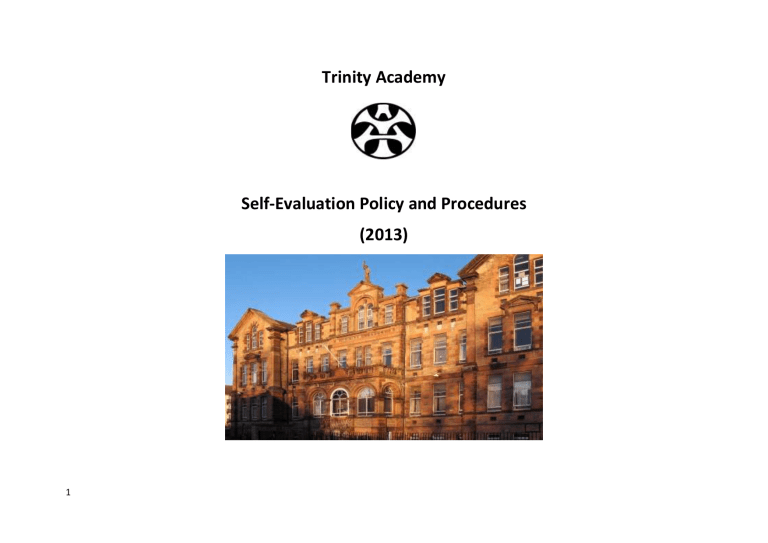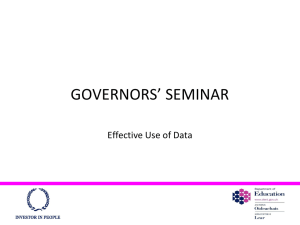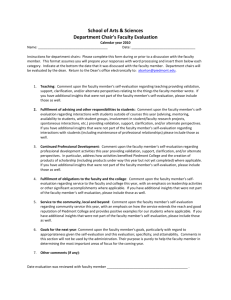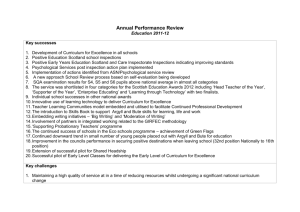Self Evaluation Policy

1
Trinity Academy
Self-Evaluation Policy and Procedures
(2013)
Contents
Introduction
Purpose of Self-evaluation
Process of Self-evaluation
Programme of Self-evaluation
Self-evaluation, Improvement Planning and the Quality Indicators
Appendices:
Appendix 1: School Self-evaluation Calendar
Appendix 2: Sharing Classroom Experience Procedures
Appendix 3: Education Scotland’s Quality Indicators (& Six-point Scale)
Appendix 4: Reference Documents
2
Page
2
2
2 - 3
5 - 6
7
8 - 9
10
11 - 12
13
Introduction
The purpose and function of a school is to cater for the needs of society in general and those of its learners in particular.
This leads us to the position that as professionals, teachers must be accountable to our employers, HMIe, parents/carers, learners, the Parent Council and the wider community. This policy statement sets out both a framework and process for self-evaluation in Trinity Academy.
Purpose of Self-evaluation
The prime purpose of self-evaluation is to improve outcomes for our learners. Self-evaluation is an established part of our improvement planning cycle and is a key management tool for development at all levels. It informs our strategic and improvement plans and helps us focus on our priorities for development.
We are committed to self-evaluation at Trinity Academy. Our procedures are designed to ensure we know ourselves well at individual, faculty and whole school level. The Joint Leadership Team* has a responsibility to monitor the effectiveness of faculties, teachers, courses and policies. Classroom teachers also have a responsibility to constantly evaluate their own lessons and classroom management with a view to improving effectiveness. All monitoring and evaluation in Trinity
Academy will take place with a view to collegially improving our performance.
Process of Self-evaluation
Self-evaluation is a process, not an event. It is the first, essential step in a cyclical process of bringing about change and improvement. It is based on professional reflection, challenge and support among practitioners. Effective self-evaluation involves taking wide-ranging decisions about actions which result in clear benefits for all learners. Most of all, it is about striving for excellence.
* The Joint Leadership Team (JLT) comprises the Senior Leadership Team(SLT), Curriculum Leaders, Pupil Support Leaders and the Support for
Pupils Leader.
3
At the heart of our self-evaluation are three questions:
How well are we doing?
How do we know?
How can we improve things further?
The emphasis of our self-evaluation is always on outcomes for learners - on an evaluation of the impact of each aspect of provision on the standards and wellbeing of learners. We strive to make the process of self-evaluation continuous and a regular part of the school’s working life based on a wide range of information about the strengths and areas for improvement collected throughout the year. The cyclical nature of our self-evaluation is illustrated in the following diagram:
Monitoring and evaluating
Planning for improvement
Undertaking improvement work
4
Programme of Self-evaluation
We strive to ensure that our self-evaluation programme:
is open and honest
has learners’ achievements and experiences as the principal focus
is a continuous process
is embedded in strategic planning and draws on regular quality assurance procedures
involves all staff at all levels in assessing outcomes and performance
seeks the views of learners systematically and consults other stakeholders where appropriate
seeks to make judgements in the light of measurable performance data and to identify trends over time
leads to improvement plans which are monitored against clear targets and success criteria
results in improvements in standards and quality for learners.
5
The activities in our school self-evaluation programme are illustrated below:
Peer review
(Neighbourhood and Cluster HTs)
Self-evaluation by Quality
Improvement
Team (reports & visits)
Reviewing progress against improvement plan
(IP Working
Groups)
SLT Faculty reviews (annual
& mid-session)
Analysing pupil performance
(Tracking,Faculty reviews)
Improving learners' standards and wellbeing
Taking account of parents/carers and other stakeholders' views
Observing learning and teaching
Taking account of learners' views
Scrutinising pupils' work
Moderating teacher assessment
6
7
Self-evaluation, Improvement Planning and the Quality Indicators
As indicated previously. Self-evaluation is not an end in itself. We use information from self-evaluation to plan for improvements and ensure a regular cyclical process of monitoring, evaluation and improvement planning. As well as providing immediate feedback for teaching staff, faculty heads and senior leaders, information from our programme of self-evaluation activities contribute towards the annually updated Standards and Quality Report which is a reflection of the school’s performance against key quality indicators. This report provides the opportunity to identify strengths, celebrate and share good practice, as well as highlighting areas for improvement. There is a close match between the outcomes of the report and priorities in the School Improvement Plan.
Central to our self-evaluation and improvement planning process are the quality indicators published by Education
Scotland (HGIOS 3 and subsequent Advice Notes). The quality indicators are listed in appendix 3 (current improvement plan priorities are in bold)
Appendix 1
Trinity Academy: Self-evaluation Calendar 2013-14
SQIP: Staff/Pupil/Parent Consultation
SQIP: SIP priorities reviewed by IP Working Groups
SQIP: Full Report Submitted to QI Team
SQIP: Review of QIs – 1.1
Attainment Report submitted to QI Team
Review of attainment with Neighbourhood HTs
SQIP: Review of QIs – 2.1 (submission to QI Team)
SQIP: Review of QIs – 5.1 (submission to QI Team)
SQIP: Review of QIs – 5.3 (submission to QI Team)
Cluster Improvement Plan: Annual Review (Cluster HTs)
Cluster Improvement Plan: submitted to QIO Team
Cluster Working Groups: Literacy, numeracy, HWB etc.
Faculty/Subject Reviews (HT, DHT, CL): including attainment
Sharing Classroom Experience: Learning Walks (JLT)
Sharing Classroom Experience: Learning Teams
Sharing Classroom Experience: Pupil Trails
8
Aug Sep Oct Nov Dec Jan Feb Mar Apr May Jun
Staff Focus Groups
Pupil Focus Groups
Staff Questionnaires
Pupil Questionnaires
Parent/Carer Questionnaires
Additional pupil feedback: Pupil Council Meetings
Additional parent/carer feedback: Parent Council Meetings
Assertive Mentoring Programme (daily)
Tracking & Full Reports S1
S2
S3
S4
S5/6
PSL 1:1 interviews with caseload
Review of partnership working (including service level agreements)
Health & Safety checks (whole school, Science, DT, FCT)
Key
Consultation
Review/Evaluation
Aug Sep Oct
Self-evaluation Submissions
Sharing Classroom Experience
Nov Dec Jan
Monitoring/Tracking
Full Reports
Feb Mar Apr May Jun
9
Appendix 2: Sharing Classroom Experience Procedures
We have three broad categories of sharing classroom experience:
Learning Walks
These are carried out by our Joint Leadership Team (JLT) and focus on our key learning and teaching priorities. They take place throughout the school year with Senior Leaders carrying out observations in their link faculties and Curriculum
Leaders monitoring work within their own subject areas. Teachers are given advance notice of these classroom visits and typically, a member of the JLT would spend 20-30 minutes in a lesson. A record of each observation is made by the school leader, oral feedback is given to the individual teacher and a summary written report prepared which highlights strengths and identifies areas for development. The report is distributed to faculty members and discussed at a faculty meeting.
Learning Teams
Learning Teams is an alternative approach to sharing classroom experience. Teachers usually work in “triads” with two observing and one teaching. There is a recording sheet which is purely for the three teachers involved which promotes constructive discussion with a focus on improving learning and teaching. Our timetabled Inter-disciplinary Learning programme (S1-S4) has necessitated the establishment of informal learning teams across the school. In 2012/13, we piloted more a formal approach in Science, FCT and Music. Learning Teams are to be extended in session 2013/14 with a view to all teaching staff being involved by the end of session 2014/15.
Pupil Trails
These are carried out by our Pupil Support Leaders and Support for Learning staff. In the main, staff have observed pupils with additional support needs with a view to assessing the effectiveness of agreed support strategies. Reports are shared with senior leaders, curriculum leaders and all teaching staff. The development of Pupil Trails is a priority in the School
Improvement Plan.
10
Appendix 3: Quality Indicators and the Six-point Scale (Education Scotland)
(current priorities in bold)
1.1 Improvements in performance
1.2 Fulfilment of statutory duties
2.1 Learners’ experiences
2.2 School’s success in involving parents, carers and families
3.1 The engagement of staff in the life and work of the school
4.1 The school’s success in working with and engaging with the local community
4.2 The school’s success in working with and engaging with the wider community
5.1 The curriculum
5.2 Teaching for effective learning
5.3 Meeting learning needs
5.4 Assessment for learning
5.5 Expectations and promoting achievement
5.6 Equality and fairness
5.7 Partnerships with learners and parents
5.8 Care, welfare and development
5.9 Improvement through self-evaluation
6.1 Policy review and development
11
6.2 Participation in policy and planning
6.3 Planning for improvement
7.1 Staff sufficiency, recruitment and retention
7.2 Staff deployment and teamwork
7.3 Staff development and review
8.1 Partnerships with the community, educational establishments, agencies and employers
8.2 Management of finance for learning
8.3 Management and use of resources and space for learning
8.4 Managing information
9.1 Vision, values and aims
9.2 Leadership and direction
9.3 Developing people and partnerships
9.4 Leadership of improvement and change
The Six-point Scale
LEVEL 6
LEVEL 5
LEVEL 4
LEVEL 3
LEVEL 2
LEVEL 1 excellent very good good adequate weak unsatisfactory outstanding or sector leading major strengths important strengths with areas for improvement strengths just outweigh weaknesses important weaknesses major weaknesses
12
Appendix 4: Reference Documents
How Good Is Our School?
The Inspection Advice Note 2013-14
CfE Implementation Plan 2013-14
HMIe (Education Scotland), 2007
Education Scotland, June 2013
Education Scotland
CfE National Expectations (Self-evaluation Resource) Education Scotland, August 2013
CoE Self-evaluation Toolkit City of Edinburgh Council, August 2013
13





